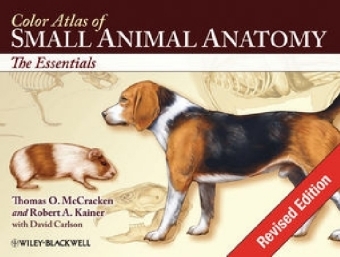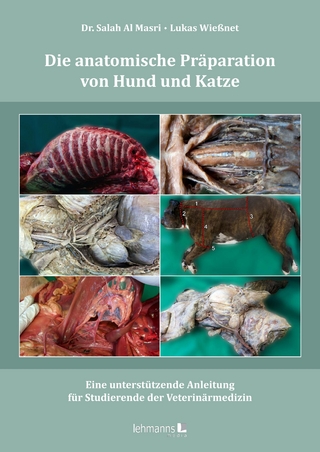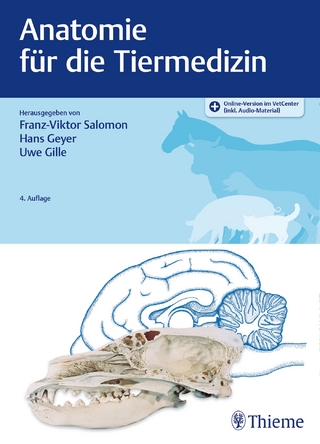
Color Atlas of Small Animal Anatomy
Wiley-Blackwell (Verlag)
978-0-8138-1608-1 (ISBN)
- Titel z.Zt. nicht lieferbar
- Versandkostenfrei
- Auch auf Rechnung
- Artikel merken
The Atlas depicts topographic relationships of major organs in a simple, yet technically accurate presentation that's free from extraneous material so that those using the atlas can concentrate on the essential aspects of anatomy. It will be an invaluable resource for veterinary students, teachers and practitioners alike.
Thomas O. McCracken, MS, is Professor of Anatomy & Physiology at Robert Ross International University of Nursing (IUON) in Basseterre, St Kitts, West Indies; and Former Associate Professor of Anatomy at the College of Veterinary Medicine and Biomedical Sciences, Colorado State University. Robert A. Kainer, DVM, MS, is Professor Emeritus of Anatomy at the College of Veterinary Medicine and Biomedical Sciences, Colorado State University, Fort Collins, Colorado.
Section 1. The Dog.
Plate 1.1 Lateral view of the dog (Beagle).
Plate 1.2 Lateral view of the bitch (Retriever).
Plate 1.3 Body regions.
Plate 1.4 Skeleton.
Plate 1.5 Cutaneous muscles and major fasciae the dog.
Plate 1.6 Superficial muscles of the bitch.
Plate 1.7 Deep muscles of the dog.
Plate 1.8 Deep cervical muscles, major joints, and in situ viscera of the bitch.
Plate 1.9 Paraxial view of the third digit.
Plate 1.10 Palmar views of the major structures of the forepaw; plantar view of the major structures of the hidpaw.
Plate 1.11 Median section of the head, and dentition.
Plate 1.12 The eye and accessory ocular structures.
Plate 1.13 The nose.
Plate 1.14 The ear.
Plate 1.15 Mouth and tongue and esophagus.
Plate 1.16 Ventral view of the abdomen and its structures.
Plate 1.17 Large intestine, anus and anal sacs.
Plate 1.18 Body cavities and serous membranes.
Plate 1.19 Thoracic, abdominal and pelvic viscera related to the skeleton of the dog.
Plate 1.20 Thoracic, abdominal and pelvic viscera, and mammary glands of the bitch.
Plate 1.21 Hip joint.
Plate 1.22 Location of major endocrine organs.
Plate 1.23 Relations of the reproductive organs of the dog.
Plate 1.24 Relations of the reproductive organs of the bitch.
Plate 1.25 Major veins.
Plate 1.26 Major arteries.
Plate 1.27 Lymph nodes and vessels.
Plate 1.28 Central and somatic nervous system.
Plate 1.29 Autonomic nervous system.
Plate 1.30 Brain, dorsal, ventral and lateral views.
Section 2.
The Cat.
Plate 2.1 Lateral view of the male cat (Moggie-nonpedigree).
Plate 2.2 Lateral view of the female cat (Persian).
Plate 2.3 Endocrine organs and lymph nodes.
Plate 2.4 Skeleton.
Plate 2.5 Cutaneous muscles and major fasciae of the male.
Plate 2.6 Superficial muscles of the female.
Plate 2.7 Middle muscles and in situ viscera of the male.
Plate 2.8 Deep muscles and in situ viscera of the female.
Plate 2.9 Median section of the head, and dentition.
Plate 2.10 Oral cavity, tongue, pharynx and esophagus.
Plate 2.11 The external, middle, and inter ear.
Plate 2.12 The eye and accessory ocular structures.
Plate 2.13 Isolated stomach and intestines.
Plate 2.14 Large intestine, anus and anal sacs.
Plate 2.15 Superficial and deep structures of the paw (foot) lateral view.
Plate 2.16 Plantar views of the major structures of forepaw and hindpaw.
Plate 2.17 Thoracic, abdominal and pelvic viscera related to the skeleton of the male.
Plate 2.18 Thoracic, abdominal and pelvic viscera, related to the skeleton of the female.
Plate 2.19 Relations of the reproductive organs of the male.
Plate 2.20 Relations of the reproductive organs of the female.
Plate 2.21 Major veins.
Plate 2.22 Major arteries.
Plate 2.23 Central and peripheral nervous system.
Plate 2.24 Brain, dorsal, ventral and lateral views.
Section 3.
The Rabbit.
Plate 3.1 Lateral view.
Plate 3.2 Body regions.
Plate 3.3 Skeleton.
Plate 3.4 Endocrine organs and lymph nodes.
Plate 3.5 Superficial muscles of the male.
Plate 3.6 Deep muscles of the female.
Plate 3.7 Median section of the rabbit’s head and dentition.
Plate 3.8 Oral cavity, tongue, pharynx and esophagus.
Plate 3.9 Thoracic, abdominal and pelvic viscera (in situ) of the male.
Plate 3.10 Thoracic, abdominal and pelvic viscera (in situ) of the female.
Plate 3.11 Relations of the reproductive organs of the male.
Plate 3.12 Relations of the reproductive organs of the female.
Plate 3.13 Central and peripheral nervous system.
Plate 3.14 Brain, dorsal, ventral, and lateral views.
Section 4.
The Rat.
Plate 4.1 Lateral view.
Plate 4.2 Skeleton of the rat.
Plate 4.3 Superficial muscles of the male.
Plate 4.4 Deep and middle muscles of the female.
Plate 4.5 Median section of the head and dentition.
Plate 4.6 Ventral view of abdominal structures (in situ) and diagram of digestive system.
Plate 4.7 Thoracic, abdominal and pelvic viscera related to the skeleton of the male.
Plate 4.8 Thoracic, abdominal and pelvic viscera, related to the skeleton of the female.
Plate 4.9 Relations of the reproductive organs of the male.
Plate 4.10 Relations of the reproductive organs of the female.
Plate 4.11 Spinal nerves.
Plate 4.12 Autonomic nerves.
Plate 4.13 Brain, dorsal, ventral, and lateral views.
Plate 4.14 Brian, sagittal section, and detail of midbrain.
Section 5.
The Guinea Pig.
Plate 5.1 Lateral view.
Plate 5.2 Skeleton.
Plate 5.3 Superficial muscles of the male.
Plate 5.4 Deep and middle muscles of the female.
Plate 5.5 Median section of the head and dentition.
Plate 5.6 Ventral view of abdominal structures (in situ) and diagram of digestive system.
Plate 5.7 Thoracic, abdominal and pelvic viscera related to the skeleton of the male.
Plate 5.8 Thoracic, abdominal and pelvic viscera, and mammary glands of the female.
Plate 5.9 Relations of the reproductive organs of the male.
Plate 5.10 Relations of the reproductive organs of the female.
Plate 5.11 Central and peripheral nervous system.
Plate 5.12 Brain dorsal, ventral, and lateral views
| Co-Autor | David Carlson |
|---|---|
| Verlagsort | Hoboken |
| Sprache | englisch |
| Maße | 224 x 305 mm |
| Gewicht | 522 g |
| Themenwelt | Veterinärmedizin ► Vorklinik ► Anatomie |
| Veterinärmedizin ► Klinische Fächer ► Pathologie | |
| Veterinärmedizin ► Kleintier | |
| ISBN-10 | 0-8138-1608-4 / 0813816084 |
| ISBN-13 | 978-0-8138-1608-1 / 9780813816081 |
| Zustand | Neuware |
| Informationen gemäß Produktsicherheitsverordnung (GPSR) | |
| Haben Sie eine Frage zum Produkt? |
aus dem Bereich


